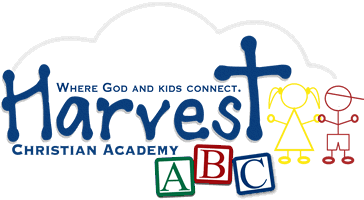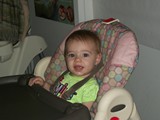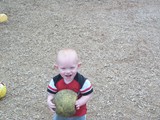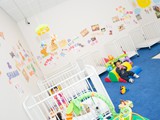It is truly amazing how much babies grow during their first year. From the moment a baby is born they are ready to learn and it is up to both parents and caretakers to ensure they maximize each of the infant’s potential through stimulation. Rocking, holding, feeding, talking, singing, and playing are just a few of the ways we help your babies develop emotionally, physically, and intellectually.
Our teachers take the time to develop a special bond with your baby, which will allow them to understand the cue’s they are given. Has she discovered her hands? Let’s dangle a toy above her and let her grab it, allowing her to work on her large motor skills. Has he started babbling? This is the earliest stage of talking, let’s spend time reading and singing with him.
Photo Gallery
- Cognition
- Communication
- Learning Approach
- Physical Health
- Social Development
Cognition
- Uses sounds, gestures, and movements to impact the environment and interactions.
- Imitating others’ actions, gestures, and sounds.
- Explores objects in many different ways.
- Observes other’s activities and may attempt to imitate.
- Shakes stuffed animal or object in same way as rattle to hear noise.
- Demonstrates object permanence, understanding people or things exist even when out of view.
- Uses object as intended.
- Reaches for a toy or object that has rolled away.
- Seeks assistant from caregiver to solve a problem by using vocalizations or gestures.
- Engages in sustained gazing or tracking of object with eyes.
- Plays with objects and toys with different sizes and shapes.
- Nests smaller objects inside larger one.
- Turns head toward sounds or voices.
- Expresses sense of wonder about the natural world.
- Shows affection.
- Enjoys rhythms and songs.
- Enjoys looking at children’s books of dance, music, theater, and visual arts.
- Enjoys repetition.
- Gazes at pictures, photographs, and mirror images.
Communication
- Responds to familiar words in home language.
- Responds to sounds in the environment.
- Recognizes familiar voice by turning towards speaker.
- Responds to “yes” & “no”.
- Responds appropriately to simple requests such as “wave bye-bye”.
- Uses consistent sound combinations to indicate specific object or person.
- Babbles using many sounds.
- Turns to look at familiar object when it is named.
- Follows single-step directions.
- Vocalizes to get attention.
- Uses a variety of inflections and sounds to express intent.
- Enjoys finger play.
- Pays attention to what the speaker is looking at or pointing to.
- Responds when name is called.
- Participates in a one-on-one conversation by making sounds.
- Makes eye contact when vocalizing.
- Pays attention to pictures in books.
- Knows how to turn pages in a book.
- Focuses attention on simple picture books.
- Brings book to adult to read.
- Grasps marker or crayon with his/her fist.
Learning Approach
- Shows interest in people by changing behavior.
- Uses all senses to explore the environment.
- Shows likes and dislikes for activities, experiences, and interaction.
- Examines a toy, rattle, or face for a brief period of time.
- Repeats simple motions or activities.
- Tries different ways of doing a task.
- Inspects own hands feet.
- Mouths, shakes, bangs, drops, or throws objects.
- Use items differently and creatively.
- Play games with primary caregiver that involves repetition.
- Applies knowledge to new situations.
Physical Health
- Lifts head and chest while on tummy.
- Supports upper body with arms while lying on tummy.
- Gains control of arm and leg movements.
- Rolls over.
- Sits with support.
- Rocks back and forth on hands and knees.
- Stands independently.
- Pulls self up to stand, holding onto something or someone.
- Walking holding onto furniture.
- Grasps caregivers fingers.
- Plays with own feet/toes and discovers hands.
- Mimics hand clapping or a good-bye wave.
- Transfers small objects from hand to hand.
- Makes marks on paper with whole movement while writing/using drawing implements.
- Child explores environment with body.
- Demonstrates increasing ability to self-soothe.
- Regulates the speed and intensity with which he/she eats.
- Explores food with fingers.
Social Development
- Quiets when comforted, especially by familiar adults, most of the time.
- Initiates and maintains interactions with caregivers.
- Distinguishes between familiar and unfamiliar adults.
- Smiles spontaneously at other children.
- Shows interest in other children by watching them and tracking their behavior.
- Reaches out to touch other children or grabs their toys.
- Begins to participate in simple parallel play with other children.
- Reacts when someone is crying or upset.
- Notices and explores hands.
- Points or moves towards desired objects.
- Repeats a motion or noise to replicate a result.
- Makes choices about what toys to play with.
- Participates in routine activities.





